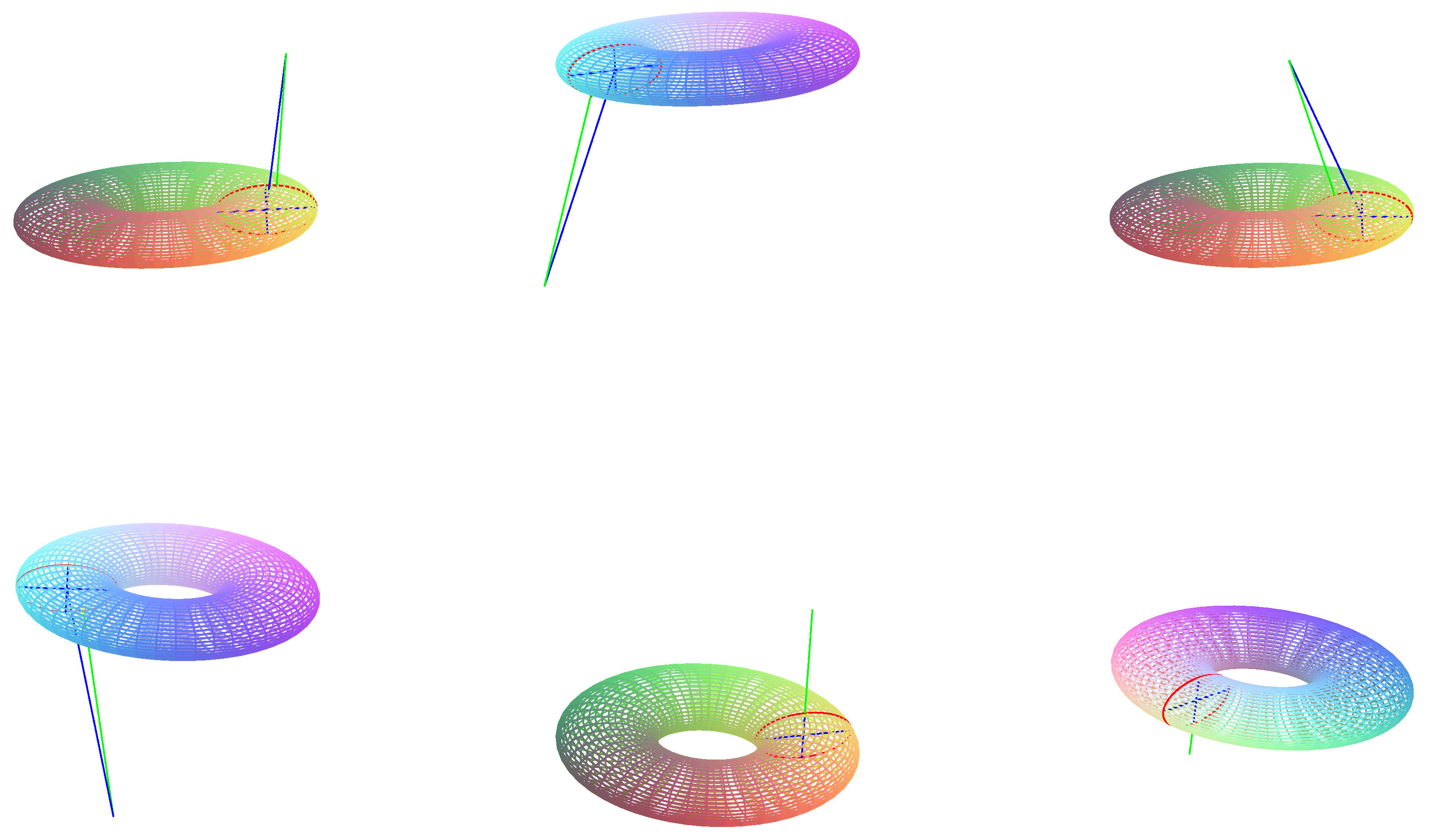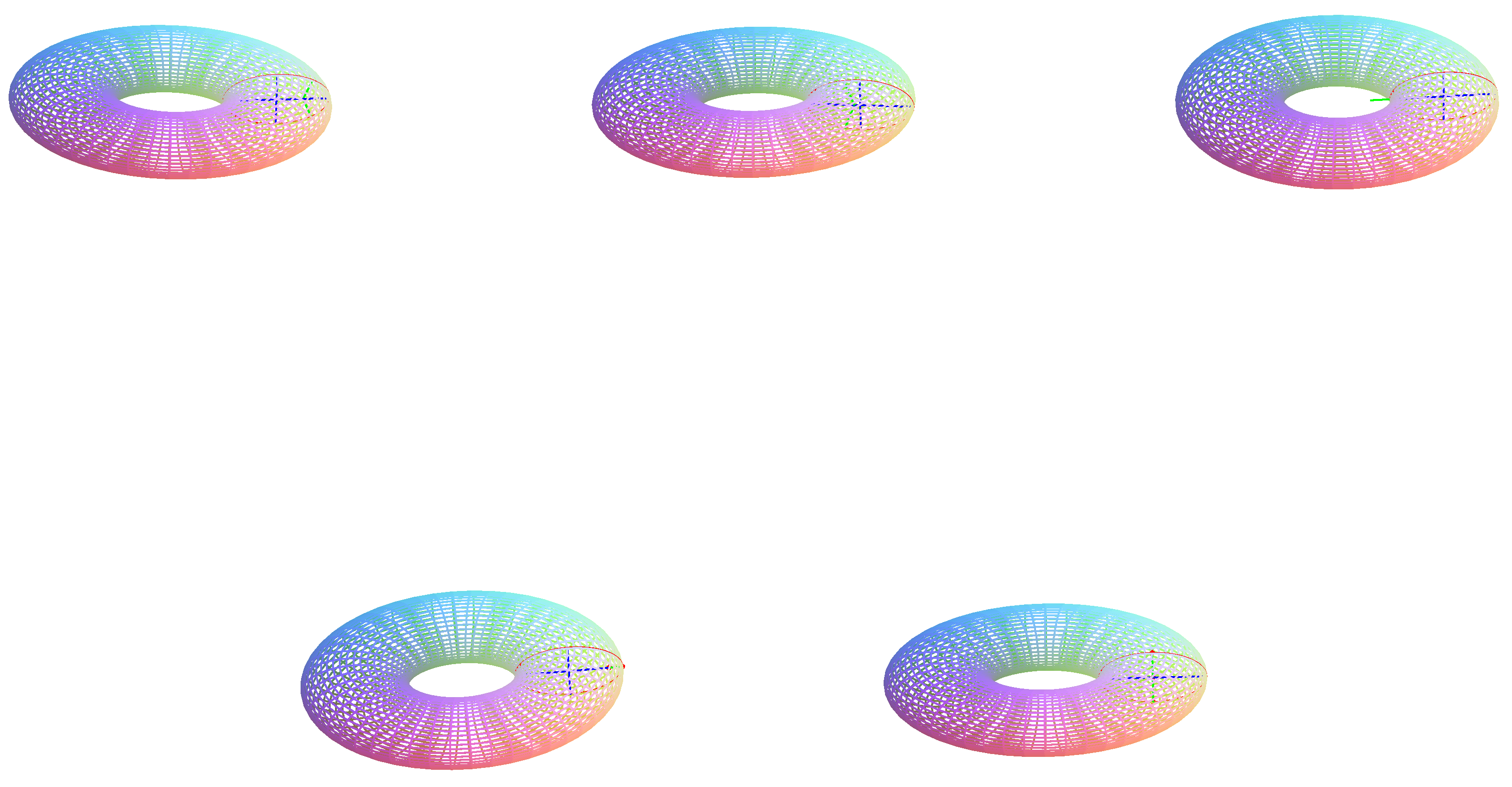The Accurate Method for Computing the Minimum Distance between a Point and an Elliptical Torus
Abstract
:1. Introduction
2. The Accurate Method for Computing the Minimum Distance between a Point and an Elliptical Torus
- (1)
- If , then the corresponding orthogonal projection point is:
- (2)
- If , then the corresponding orthogonal projection point is:
- (3)
- If , then the corresponding orthogonal projection point is:
- (4)
- If , then the corresponding orthogonal projection point is:
- (5)
- If , then the corresponding orthogonal projection point is:
- (6)
- If , then the corresponding orthogonal projection point is:
- (1)
- If , then
- (2)
- If , then .
- (1)
- If , then
- (2)
- If , then , where . In the process of computing the real roots, we delete the imaginary part of the roots and .
- (1)
- If , then the corresponding orthogonal projection point is
- (2)
- If , then the corresponding orthogonal projection point is
- (3)
- If , then the corresponding orthogonal projection point is
- (1)
- If , then the corresponding orthogonal projection point is expressed as:
- (2)
- If , then the corresponding parameter value is , so the corresponding orthogonal projection points are expressed as:and:
- (3)
- If , then the corresponding orthogonal projection points are expressed as:and:
- (4)
- If , then the corresponding parameter value is . Therefore, the corresponding orthogonal projection points are expressed as:and:
- (5)
- If , then the corresponding orthogonal projection point is expressed as:
- (1)
- If , then the corresponding orthogonal projection point is:
- (2)
- If , then the corresponding orthogonal projection point is expressed as:
- (3)
- If , then the corresponding orthogonal projection points are expressed as:and:
3. Conclusions
Acknowledgments
Author Contributions
Conflicts of Interest
References
- Ma, Y.L.; Hewitt, W.T. Point inversion and projection for NURBS curve and surface: Control polygon approach. Comput. Aided Geom. Des. 2003, 20, 79–99. [Google Scholar] [CrossRef]
- Yang, H.P.; Wang, W.P.; Sun, J.G. Control point adjustment for B-spline curve approximation. Comput. Aided Des. 2004, 36, 639–652. [Google Scholar] [CrossRef] [Green Version]
- Johnson, D.E.; Cohen, E. A Framework for efficient minimum distance computations. In Proceedings of the IEEE Intemational Conference on Robotics & Automation, Leuven, Belgium, 20–20 May 1998.
- Piegl, L.; Tiller, W. Parametrization for surface fitting in reverse engineering. Comput. Aided Des. 2001, 33, 593–603. [Google Scholar] [CrossRef]
- Pegna, J.; Wolter, F.E. Surface curve design by orthogonal projection of space curves onto free-form surfaces. J. Mech. Des. ASME Trans. 1996, 118, 45–52. [Google Scholar] [CrossRef]
- Hu, S.M.; Wallner, J. A second order algorithm for orthogonal projection onto curves and surfaces. Comput. Aided Geom. Des. 2005, 22, 251–260. [Google Scholar] [CrossRef]
- Besl, P.J.; McKay, N.D. A method for registration of 3-D shapes. IEEE Trans. Pattern Anal. Mach. Intell. 1992, 14, 239–256. [Google Scholar] [CrossRef]
- Mortenson, M.E. Geometric Modeling; Wiley: New York, NY, USA, 1985. [Google Scholar]
- Zhou, J.M.; Sherbrooke, E.C.; Patrikalakis, N. Computation of stationary points of distance functions. Eng. Comput. 1993, 9, 231–246. [Google Scholar] [CrossRef]
- Johnson, D.E.; Cohen, E. Distance extrema for spline models using tangent cones. In Proceedings of the 2005 Conference on Graphics Interface, Waterloo, ON, Canada, 9–11 May 2005.
- Hartmann, E. On the curvature of curves and surfaces defined by normalforms. Comput. Aided Geom. Des. 1999, 16, 355–376. [Google Scholar] [CrossRef]
- Limaien, A.; Trochu, F. Geometric algorithms for the intersection of curves and surfaces. Comput. Graph. 1995, 19, 391–403. [Google Scholar] [CrossRef]
- Polak, E.; Royset, J.O. Algorithms with adaptive smoothing for finite minimax problems. J. Optim. Theory Appl. 2003, 119, 459–484. [Google Scholar] [CrossRef]
- Press, W.H.; Teukolsky, S.A.; Vetterling, W.T.; Flannery, B.P. Numerical Recipes in C: The Art of Scientific Computing, 2nd ed.; Cambridge University Press: New York, NY, USA, 1992. [Google Scholar]
- Elber, G.; Kim, M.S. Geometric Constraint solver using multivariate rational spline functions. In Proceedings of the Sixth ACM Symposiumon Solid Modeling and Applications, Ann Arbor, MI, USA, 6–8 June 2001; pp. 1–10.
- Patrikalakis, N.; Maekawa, T. Shape Interrogation for Computer Aided Design and Manufacturing; Springer: Berlin, Germany, 2001. [Google Scholar]
- Selimovic, I. Improved algorithms for the projection of points on NURBS curves and surfaces. Comput. Aided Geom. Des. 2006, 23, 439–445. [Google Scholar] [CrossRef]
- Cohen, E.; Lyche, T.; Riesebfeld, R. Discrete B-splines and subdivision techniques in computer-aided geometric design and computer graphics. Comput. Graph. Image Process. 1980, 14, 87–111. [Google Scholar] [CrossRef]
- Piegl, L.; Tiller, W. The NURBS Book; Springer: New York, NY, USA, 1995. [Google Scholar]
- Liu, X.-M.; Yang, L.; Yong, J.-H.; Guf, H.-J.; Sun, J.-G. A torus patch approximation approach for point projection on surfaces. Comput. Aided Geom. Des. 2009, 26, 593–598. [Google Scholar] [CrossRef]
- Li, X.; Xin, Q.; Wu, Z.; Zhang, M.; Zhang, Q. A geometric strategy for computing intersections of two spatial parametric curves. Vis. Comput. 2013, 29, 1151–1158. [Google Scholar] [CrossRef]
- Kim, K.-J. Minimum distance between a canal surface and a simple surface. Comput. Aided Des. 2003, 35, 871–879. [Google Scholar] [CrossRef]
- Li, X.; Jiang, H.; Chen, S.; Wang, X. An efficient surface-surface intersection algorithm based on geometry characteristics. Comput. Graph. 2004, 28, 527–537. [Google Scholar] [CrossRef]
- Chen, S.-D.; Ma, W.; Xu, G.; Paul, G.-C. Computing the Hausdorff distance between two B-spline curves. Comput. Aided Des. 2010, 42, 1197–1206. [Google Scholar] [CrossRef]
- Chen, X.-D.; Xu, G.; Yong, J.-H.; Wang, G.; Paul, G.-C. Computing the minimum distance between a point and a clamped B-spline surface. Graph. Models 2009, 71, 107–112. [Google Scholar] [CrossRef] [Green Version]
- Chen, X.-D.; Yong, J.-H.; Wang, G.; Paul, G.-C.; Xu, G. Computing the minimum distance between a point and a NURBS curve. Comput. Aided Des. 2008, 40, 1051–1054. [Google Scholar] [CrossRef] [Green Version]
- Chen, X.-D.; Chen, L.; Wang, Y.; Xu, G.; Yong, J.-H.; Paul, J.-C. Computing the minimum distance between two Bézier curves. J. Comput. Appl. Math. 2009, 229, 294–301. [Google Scholar] [CrossRef] [Green Version]
- Chen, X.D.; Yong, J.H.; Wang, G.Z.; Paul, J.C.; Xu, G. Computing the minimum distance between a point and a NURBS curve. Comput. Aided Des. 2008, 40, 1051–1054. [Google Scholar] [CrossRef] [Green Version]
- Oh, Y.-T.; Kim, Y.-J.; Lee, J.; Kim, Y.-S.; Elber, G. Efficient point-projection to freeform curves and surfaces. Comput. Aided Geom. Des. 2012, 29, 242–254. [Google Scholar] [CrossRef]
- Sundar, B.R.; Chunduru, A.; Tiwari, R.; Gupta, A.; Muthuganapathy, R. Footpoint distance as a measure of distance computation between curves and surfaces. Comput. Graph. 2014, 38, 300–309. [Google Scholar] [CrossRef]
- Borkowski, K.M. Accurate algorithms to transform geocentric to geodetic coordinates. J. Geod. 1989, 63, 50–56. [Google Scholar] [CrossRef]
- Bil, T. Geometry of a mechanism with a higher pair in the form of two elliptical tori. Mech. Mach. Theory 2010, 45, 185–192. [Google Scholar] [CrossRef]
- Bil, T. Kinematic analysis of a universal spatial mechanism containing a higher pair based on tori. Mech. Mach. Theory 2011, 46, 412–424. [Google Scholar] [CrossRef]
- Haneskog, L.; Andersson, L.; Brekkan, E.; Englund, A.-K.; Kameyarna, K.; Llljas, L.; Greljer, E.; Flschbarg, J.; Lundahl, P. Monomeric human red cell glucose transporter (Glutl) in non-ionic detergent solution and a semi-elliptical toms model for detergent binding to membrane proteins. Biochim. Biophys. Acta 1996, 1282, 39–47. [Google Scholar] [CrossRef]
- Dantchev, D.; Valchev, G. Surface integration approach: A new technique for evaluating geometry dependent forces between objects of various geometry and a plate. J. Colloid Interface Sci. 2012, 372, 148–163. [Google Scholar] [CrossRef] [PubMed]
- Werner, D.H.; Jones, D.M.; Werner, P.L. The Electromagnetic Fields of Elliptical Torus Knots. IEEE Trans. Antennas Propag. 2001, 49, 980–991. [Google Scholar] [CrossRef]



© 2016 by the authors; licensee MDPI, Basel, Switzerland. This article is an open access article distributed under the terms and conditions of the Creative Commons by Attribution (CC-BY) license (http://creativecommons.org/licenses/by/4.0/).
Share and Cite
Li, X.; Wu, Z.; Hou, L.; Wang, L.; Yue, C. The Accurate Method for Computing the Minimum Distance between a Point and an Elliptical Torus. Computers 2016, 5, 4. https://doi.org/10.3390/computers5010004
Li X, Wu Z, Hou L, Wang L, Yue C. The Accurate Method for Computing the Minimum Distance between a Point and an Elliptical Torus. Computers. 2016; 5(1):4. https://doi.org/10.3390/computers5010004
Chicago/Turabian StyleLi, Xiaowu, Zhinan Wu, Linke Hou, Lin Wang, and Chunguang Yue. 2016. "The Accurate Method for Computing the Minimum Distance between a Point and an Elliptical Torus" Computers 5, no. 1: 4. https://doi.org/10.3390/computers5010004





